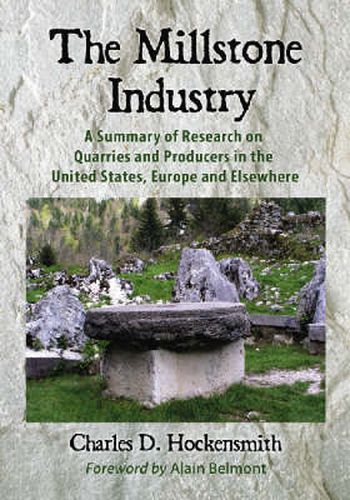Readings Newsletter
Become a Readings Member to make your shopping experience even easier.
Sign in or sign up for free!
You’re not far away from qualifying for FREE standard shipping within Australia
You’ve qualified for FREE standard shipping within Australia
The cart is loading…






This title is printed to order. This book may have been self-published. If so, we cannot guarantee the quality of the content. In the main most books will have gone through the editing process however some may not. We therefore suggest that you be aware of this before ordering this book. If in doubt check either the author or publisher’s details as we are unable to accept any returns unless they are faulty. Please contact us if you have any questions.
Since prehistoric times, the process of cutting rock to make millstones has been one of the most important industries in the world. Different civilizations and cultures have produced their own styles of grinding stones, which have been used in mills to process wheat, corn, and other grains into the flour and meal that was necessary to feed a growing population. The earliest rotary millstones, known as querns, were turned by human power. Later in history, larger millstones were manufactured that required animal, water, or wind power to turn them. These larger millstones required less human effort and ground greater quantities of grain, but also required regular maintenance and replacement. As a result, millstone quarries increased greatly in number and size in the late 19th and early 20th centuries, with the largest quarry sites extending as far as nearly a half-mile square to about 12 square miles.The first part of this book compiles information on the millstone industry in the United States, which dates between the mid - 1600s and the mid - 1900s. Primarily based on archival research and brief accounts published in geological and historical volumes, it focuses on conglomerate, granite, flint, quartzite, gneiss, and sandstone quarries in different regions and states, along with a general overview of the rise and fall of the American millstone industry. The second part focuses on the millstone quarrying industry in Europe and other areas. Of the European millstone industry, the quarries of France, Germany, and Great Britain are most extensively documented, although the quarries of Albania, Austria, the Czech Republic, Greece, Hungary, Italy, Luxembourg, Norway, Slovenia, Spain, Sweden, and Switzerland are also addressed. The book includes 84 photographs, 16 tables, and a helpful glossary of specialized and technical terms.
$9.00 standard shipping within Australia
FREE standard shipping within Australia for orders over $100.00
Express & International shipping calculated at checkout
This title is printed to order. This book may have been self-published. If so, we cannot guarantee the quality of the content. In the main most books will have gone through the editing process however some may not. We therefore suggest that you be aware of this before ordering this book. If in doubt check either the author or publisher’s details as we are unable to accept any returns unless they are faulty. Please contact us if you have any questions.
Since prehistoric times, the process of cutting rock to make millstones has been one of the most important industries in the world. Different civilizations and cultures have produced their own styles of grinding stones, which have been used in mills to process wheat, corn, and other grains into the flour and meal that was necessary to feed a growing population. The earliest rotary millstones, known as querns, were turned by human power. Later in history, larger millstones were manufactured that required animal, water, or wind power to turn them. These larger millstones required less human effort and ground greater quantities of grain, but also required regular maintenance and replacement. As a result, millstone quarries increased greatly in number and size in the late 19th and early 20th centuries, with the largest quarry sites extending as far as nearly a half-mile square to about 12 square miles.The first part of this book compiles information on the millstone industry in the United States, which dates between the mid - 1600s and the mid - 1900s. Primarily based on archival research and brief accounts published in geological and historical volumes, it focuses on conglomerate, granite, flint, quartzite, gneiss, and sandstone quarries in different regions and states, along with a general overview of the rise and fall of the American millstone industry. The second part focuses on the millstone quarrying industry in Europe and other areas. Of the European millstone industry, the quarries of France, Germany, and Great Britain are most extensively documented, although the quarries of Albania, Austria, the Czech Republic, Greece, Hungary, Italy, Luxembourg, Norway, Slovenia, Spain, Sweden, and Switzerland are also addressed. The book includes 84 photographs, 16 tables, and a helpful glossary of specialized and technical terms.